Colors of Korea
With Haeyoung-Yoomine Kim, Boram Jung, Valentina Buzzi
In the program of the Nemo Biennial
Korean Cultural Center, Paris, October 24th, 2025 - August 29th, 2026

The exhibition Colors of Korea, Spotlight on Contemporary Korean Art, presented at the Korean Cultural Center on the occasion of the 140th anniversary of diplomatic relations between France and Korea, offers a dialogue between tradition and contemporary creation by bringing together works with formal similarities. Through the works of 34 artists – from great masters to young talents – covering a wide spectrum of practices, from painting to sculpture, photography to installation, and even digital art, the exhibition celebrates the colors of Korea and invites visitors to contemplate works of art in light of sustainable and timeless criteria, offering a fresh perspective on the challenges of our time and the prospects for tomorrow.
ARTISTS _ Hejum Bä, Chae Sung-Pil, Jesse Chun, Chung Heemin, Ha Chong-Hyun, Han Sang A, Jang Kwang-Bum, Jeon Hyunsun, Kim Guiline, Helena Parada Kim, Kim Su Yeon, Kim Taek Sang, Kim Tschang-Yeul, Kim Yunchul, Koo Bohnchang, Kwon Okyon, Lee Ahnnlee, Lee Bae, Lee Kangso, Lee Ungno, Jin Meyerson, Moonassi, Park In-Kyung, Park Seo-Bo, Shin Gunwoo, Shin Kyungmi, Shinseungback Kimyonghun, Suh Se-Ok, Woo Hannah, Yeesookyung, Anicka Yi, Yoo Jisoo, Yoo Youngkuk, You Guimi.
DOCUMENTATION _ Centre Culturel Coréen.
Code + Matter
In the program of the Nemo Biennial
Galertie Joseph, Paris, October 21st - 26th, 2025

The 2020s have been a strange decade, beginning with a pandemic that indirectly brought certain digital art practices online to the attention of the general public. However, it is worth remembering that electronics have been used in art since the 1960s and works have been available on the internet since the 1990s. Among the trends that have been quietly evolving over the last sixty years and are finally coming to the fore is generative art, which is generally associated with coding practices that enable the “generation” of creations, particularly visual ones, using algorithms. Major innovations such as the personal computer, the web and then blockchain have enabled this trend to refine itself, not to mention the increase in computing power, which has significantly reduced the waiting time between doing and seeing, now accessible to the majority. Over time, communities and collectives have formed, based on languages or platforms, approaches or forms. This is how Alexis André, Julien Espagnon, William Mapan and Florian Zumbrunn came together. They share a common appetite for code, which allows them to approach creation in a serial manner, as if to exhaust their subjects. Each in their own way, they move back and forth between the immateriality of finely crafted scripts and the materiality of physical pieces. Driven by an equal desire to share, they continue their abstract adventure by reactivating their approaches in new ways. And as is generally the case in generative art, their creative processes should be considered as essential components of works that are ‘frozen’ at specific moments in time.
ARTISTS _ Alexis André, Julien Espagnon, William Mapan et Florian Zumbrunn.
DOCUMENTATION _ Code + Matter.
Science and fiction
With Annso Boulan
In the program of the CURA project of the CNAP
Scène nationale, Aubusson, October 16th - december 12th, 2025

What could be more natural in Aubusson than exhibiting woven fabrics? However, Cécile Babiole's creations are somewhat unusual: they can be listened to as well as observed, as the artist has woven cables that broadcast sound loops and form visual patterns. Donatien Aubert refers to Jeremy Bentham, the inventor of panoptic prison architecture, to bring us into the present day by evoking in his film the feeling of constant surveillance, which scientists study and authors fictionalise. Véronique Béland has merged dreams that a machine of her own design releases by printing them before they fade away. The Quebec artist's generative installation depicts the little frustrations that our alarm clocks generate! For its part, the Obvious collective understands the importance of the unconscious in art when it designs the Mind-to-Image process, which aims to use brain waves to generate images evoking surrealism. This idea of art that is not entirely intentional is revived by the widespread use of generative artificial intelligence. Letting go and introspection are the order of the day in Jeanne Susplugas' creations, with shimmering sculptures reminiscent of the shapes of psychotropic molecules that affect our states of consciousness, as well as a virtual reality installation with synaptic settings that has just entered the Centre Pompidou's collection. Finally, there is the astrobotanical herbarium that photographer Vincent Fournier has compiled, taking into account the environmental conditions offered by a few distant exoplanets.
ARTISTS _ Donatien Aubert, Cécile Babiole, Véronique Béland, Vincent Fournier, Obvious, Jeanne Susplugas.
PERFORMANCE _ Annabelle Playe, Hugo Arcier, Rima Ben Brahim & Marc Siffert, Ars Natura.
VJ SET _ Verginie Descente.
DOCUMENTATION _ Scène nationale d'Aubusson.
Memory Coexistence
With Maria Grazia Mattei, Yuelai Ruan & Susa Pop
MEET Digital Culture Center, Milan, October 2 - November 2, 2025
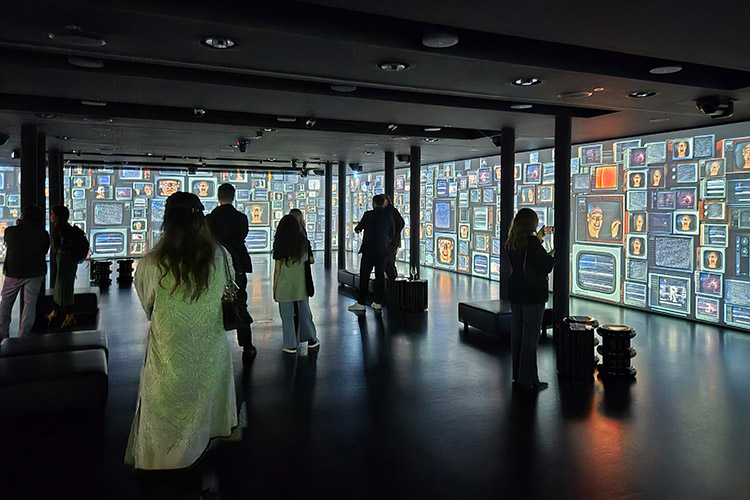
Memory Coexistence stems from the experience of the City Digital Skin Art festival, a project that promotes digital art as a large participatory event, held in various cities across Asia and Europe. While the CDSA Festival 2025 continues to bring digital art to urban public spaces, using the LED surfaces of cities, Memory Coexistence shifts this research to the museum space, thus creating a dialogue between the public and institutional environments.
ARTISTS _ Ban Ling Sheng, Chen Can Rong, Ruan Yuelai, DigitalFun, George Yankov, Yang Xue Ning, Zheng Jing, Lu Ying Ying, Chen Zhi Hao, Ruan Xiao Quing, Léo Sallanon, Wu Jian Bin, Spinor, Li Zhen, Zheng Hai Yu, ZorkArt, Yang Qi Rui, Yu Zhen + Team, Gao Shiqiang + Team, Wang Feng, Luo Bao Quan, DAI Yanliang, H1H Art, Chuang Qiao, Lee Lee Nam, Mark Chavez, Ina Conradi + Media Art Nexus, MP studio, Wang Shuai, Xu Xiao Hua.
DOCUMENTATION _ MEET.
Mesophotic
Galerie Data, Paris, May 22nd - 31st, 2025

Paul Duncombe’s artistic practice is exploratory in nature. He enjoys the company of scientists, which gives him access to worlds that are not quite our own. In the Pacific Ocean, his work takes shape through a series of underwater dives, from which he brings back clues that allow him to create, in his studio, the images and sounds he presents as installations and performances. One of his essential concerns is the living world and its transformations in this era of the Anthropocene. He observes life, notably at depths where the diminishing light can no longer activate colors. Unless this shift to black and white, especially concerning coral reefs, is due to global warming, the causes of which we know. Sometimes, he is forced to delegate his observations to those who practice technical diving, equipping them with cameras and accompanying them via an underwater drone. With the data collected, he represents these strange territories where animals, without humans, would continue to evolve in symbiosis with plants and minerals. The use of processes such as photogrammetry allows him to move his virtual cameras more fluidly within these otherworldly, relatively transparent landscapes. With access to an electron microscope, he continues his investigations at the scale of the microorganisms inhabiting the corals, to discover their structures. The result evokes meticulous, not to say obsessive, drawing practices. By subjecting samples to infrared lighting, he reveals their bioluminescence, which, in the darkness of the depths, becomes a vector of language for living beings. With Paul Duncombe, the exhibition space takes on the appearance of a laboratory where the aesthetic experience is articulated around meticulous observation. The artist designs his own display devices, allowing him to classify aquatic organisms of the most diverse forms-mollusks and other crustaceans that never cross our paths, yet still suffer the consequences of our very existence. When he focuses on a fish larva, it is to scrutinize its pulsations, which, in proportion to its tiny size, reveal the extreme fragility of a global ecosystem. And when only the external skeletons or shells of these living beings remain, he uses radioactive elements to test their levels of protection should the worst occur. For the work that Paul Duncombe weaves through his experiences, from the natural environment to the exhibition laboratory, aims-beyond the aesthetic pleasure it provides-to awaken our consciousness.
ARTIST _ Paul Duncombe.
DOCUMENTATION _ Galerie Data.
Sculpting the invisible
With Davide Sarchioni
NM Contemporary Gallery, May 8th - September 8th, 2025

Among the innovations that Antonio Barbieri also makes great use of are the technologies of electroencephalography, which allow him to consider his emotional states and give them forms by manipulating data sets. It is indeed a question here, in entry, of a form of introspection that the artist communicates to us, in exit, by arranging glass fragments to obtain mosaics. Thus combining its technological know-how with others, more ancestral. Finally, his spherical harmonics are at the crossroads of these multiple practices. Initially, there is his fascination for mathematics with, in this case, the theory that gives its name to the series. This allows it to algorithmically recombine data of different natures, coming from the inside for those captured with an electroencephalographic helmet, and from the outside when it comes to the captures of its environment. Both an attempt to be one with the world around us and reconnect with nature.
ARTIST _ Antonio Barbieri.
DOCUMENTATION _ NM Contemporary.
Art by iteration
With Danae
Art Dubai, April 18th - 20th, 2025

In mathematics, iteration refers to repetition, while in art it evokes series. This brings to mind the serial approach of artists repeating their prompt to get closer to the masterpiece.
ARTISTS _ Agoria, Lionel Bayol-Thémines, Louis-Paul Caron, Chun Hua Catherine Dong, Alice Gordon, Fabin Rasheed, Bernar Venet.
DOCUMENTATION _ Danae.
The Narrative Experience
AI Action Summit, Grand Palais, Paris, February 10th - 11th, 2025

Art history teaches us that the value of inventions also stems, and perhaps above all stems, from their broad adoption. That goes for photography, which was invented by Niépce, improved by Daguerre and ultimately brought to the masses by Kodak, long before digital companies took up their mantle. ln recent years, generative artificial intelligence has found itself at the centre of our concerns and practices. lt has changed our relationship with reality, now that we can all tell stories to machines that interpret them "in the style of" what they have been taught. ln that context, in art and society more broadly, we have seen great enthusiasm for narration. And we have seen that the precision of prompts, the invoking the very essence of poetry, enables algorithms to refer to the right images in datasets of unimaginable sizes. Does that mean we are all potential artists? Yet artists are showing great determination in coming doser, in successive iterations, to producing masterpieces, by developing narration through images and in series that could go on forever. What we are seeing today is not so mucha revolution of pictures, but a revolution of the imagination.
ARTISTS _ Agoria & Johan Lescure, Refik Anadol, Sofia Crespo, Chun Hua Catherine Dong, Linda Dounia, Alice Gordon, Holly Herndon & Mathew Dryhurst, Milkorva, Niceaunties, Obvious, Fabin Rasheed, Sabrina Ratté, Cecilie Waagner Falkenstrøm.
DOCUMENTATION _ Sommet pour l’Action sur l’IA, YouTube.
Nano Particles Genesis
Alberta Pane Gallery, Paris, February 1st - March 29th, 2025
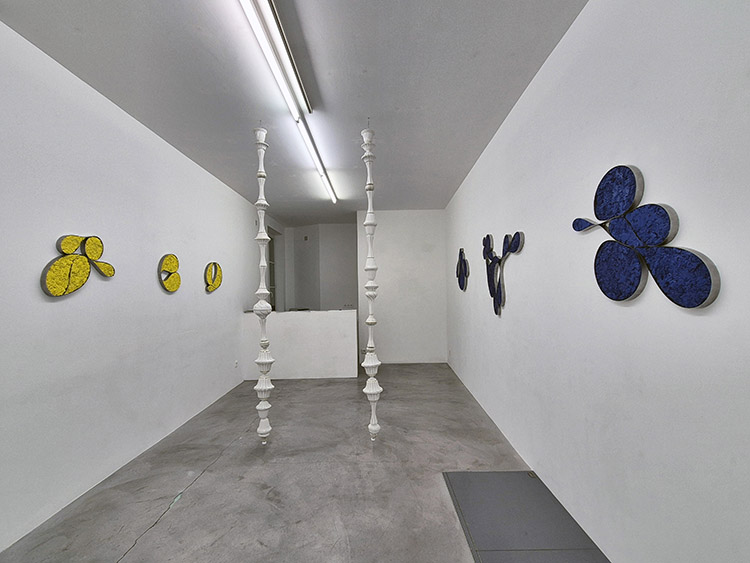
This exhibition shows the evolution of Michelangelo Penso's research on magnetic nanoparticles - a process that began in 2023 during his collaboration with the IIT (Italian Institute of Technology) - through a new installation entitled Magnetic nanoparticles Genesis, as well as wall works inspired by molecular or cellular biomarkers.
ARTIST _ Michelangelo Penso.
DOCUMENTATION _ Alberta Pane.
Extended
With Approche & Ikigai Labs
Spatial, online, November 15th - 17th, 2024

The question of context in art is essential, and it comes in many different forms. Throughout history, the society in which a work of art emerges imprints itself upon the work to the point that it reflects its social and political environment. In art history, aesthetic ruptures also stem from successive places of production: monuments, workshops, and natural environments now give way to the studio, an elsewhere that artists access with their connected devices. Sometimes, it is even the context of the artwork’s presentation that reveals it, as in the case of the ready-made. To the point where one might question the strange presence of a red fire extinguisher in a white cube. But what about virtual galleries, which, while adopting the codes of contemporary art, continue the experience in a different way? The public’s relationship with art is obviously quite different there. Thus, works that continue online, losing their materiality, create a different kind of relationship that, to some extent, is more intimate. This is why the experience we are discussing here with extended must be lived in order to access works that reflect both the physical or immaterial places from which they have just emerged and a universal «now.»
ARTISTS _ Lionel Bayol-Thémines, Daniel Bourgais, Brodbeck & de Barbuat, Albertine Meunier, Edouard Taufenbach & Bastien Pourtout.
DOCUMENTATION _ Ikigai Labs.
Beyond the Screens
With Ina Conradi, Susa Pop & Yuelai RuanCity Digital Skin Art (CDSA), Hangzhou, October 23nd - 28th, 2024
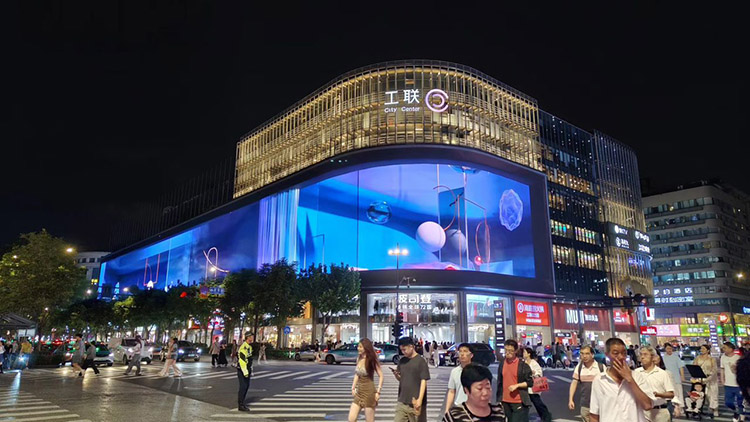
ARTISTS _ CDSA Awards Winners.
DOCUMENTATION _ City Digital Skin Art Awards.
[Un]Real
During Art Basel
With Janine Sarbu, Santiago Torres & 36°
Metahaus, Paris, October 18th - 25th, 2024
![[Un]Real](../img/exhibitions/unReal.jpg)
We will never again observe images as we did before the unbridled use of generative artificial intelligence. One could argue that this is nothing new, considering the emergence of photography, its democratization, its analog and then digital manipulations, as well as images that used to be called computer-generated imagery. Yet something more profound has happened in recent years, in recent months, forever altering our relationship to facts, not to mention reality. Echoing Kodak's invention of film, which made it possible to instantly capture images on the spot, online artificial intelligence platforms now enable us to easily produce figments of our imaginations. Imagination is taking precedence over reality, while at the same time prolonging our thirst for what’s virtual. The idea that we are all, at last, artists is re-emerging. But let's not be mistaken: if a few words are all it takes to create, only a sharp eye can improve the result until it becomes an artwork. As for contemporary creations that still have a touch of materiality, they also tell us of the visceral attachment we have kept with the tangible, or the real. We simply observe and interpret them differently in this era of a form of post-reality.
ARTISTS _ Fabrice Ainaut, Matteo Basilé, Lionel Bayol-Thémines, Salom Chartriot, Niko De La Faye, Emo De Medeiros, Violet Forest, Thomas Garnier, Raphaël Guez, Marie Maillard, Milkorva, Minuit Digital, Juan Le Parc, Julio Le Parc, Tom Lelouche, Claire Malrieux, Vincenzo Marsiglia, Jean-Baptiste Perrot, François Ronsiaux, Bruno Ribeiro, Diego Sarmiento, Santiago Torres, U2P050, Thomas Vanz, Visual System, Brankica Zilovic.
Disturbing Strangeness
With Annso Boulan
In the program of the CURA project of the CNAP
Scène nationale, Aubusson, October 12th - November 24th, 2024
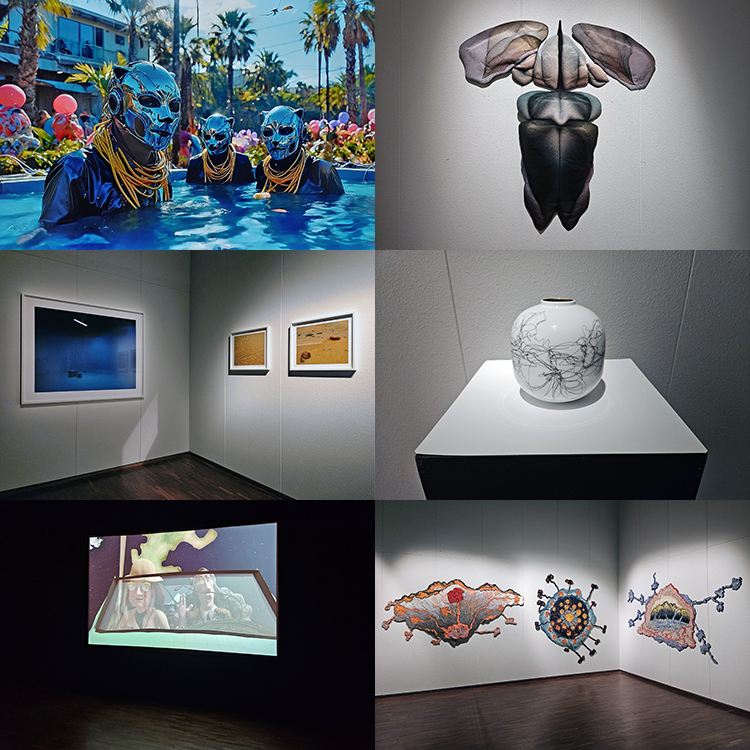
The CURA project, supported by CNAP, continues with the exhibition Disturbing Strangeness, a continuation of Alternative Realities. This second event is dedicated to those elements which, however minute, stir our consciences in art as in life. Or when strangeness is the rule.
ARTISTS _ Caroline Delieutraz, Bertrand Dezoteux, Marina Gadonneix, Michel Paysant, Systaime, Brankica Zilovic.
DOCUMENTATION _ Scène nationale d'Aubusson.
What brings us together:
Languages and imaginaries
In the program of the Festival of francophonyLa Gaîté Lyrique, Paris, October 2nd - 6th, 2024

Languages can unite, but sometimes their differences divide us, and there are universal languages including those of arts and sciences. It’s interesting to notice that ideas, with the avant-gardes of the previous century, started to predominate images, sometimes to the point of words alone making artworks. The exhibition What brings us together gathers creations with very diverse forms from here and there to scrutinize usages of languages serving imaginaries. Transmission technology, such as morse code or radio waves, are bent by some artists with adventurous practices going so far as to focus on inter-species means of communication. There are also books, among other contents and trends extracted from the Internet, without forgetting the essential role of algorithms in contemporary creation. A common point to the artworks of this exhibition is that all of them can be considered as doors to our collective imaginaries at the crossroads of art and knowledge.
ARTISTS _ Cécile Babiole & Jean-Marie Boyer, Véronique Béland, Michel de Broin, Caroline Delieutraz, Pascal Dombis, Linda Dounia, Flore Eckmann, Mounir Fatmi, Thomas Garnier, Vidya-Kelie Juganaikloo, Eduardo Kac, So Kanno & Takahiro Yamaguchi, LAB[au], Lionel Maes, Rachel Marks, Yucef Merhi, Caroline Monnet, Tania Mouraud, Iván Navarro, Bertrand Planes, Julien Prévieux, Vera Röhm, Christa Sommerer & Laurent Mignonneau, Sacha Stiles, Moffat Takadiwa, Ali Tnani, Bernar Venet, Filipe Vilas-Boas, Young-Hae Chang Heavy Industries, Brankica Zilovic, Fabien Zocco et Mathieu Zurstrassen.
DOCUMENTATION _ Festival of francophony.
Boundaries
With Walter Vanhaerents
During the Venice Biennale
Santa Maria della Visitazione, Venice, April 20th - November 24th, 2024

In essence, this piece is about boundaries–those imaginary, fluid barriers. The imaginary boundaries between ourselves and our environment, body and soul, the material and the immaterial. Yet, boundaries are merely constructs of our human mind. We are not separate from the universe; we are not even in it–we are integral parts of its fabric. Just as waves are manifestations of the ocean, we are manifestations of the universe. And while we are subatomic waves dancing in cosmic quantum fields, we also dance at the macroscale. We dance to express ourselves, to connect with each other, our environment and the ‘divine’. We dance to experience union with the universe directly. Boundaries aims to induce a contemplative experience, encouraging us to reflect on these ideas.
ARTIST _ Memo Akten.
DOCUMENTATION _ Vanhaerents Art Collection.
Society
On CIFRA, since april 2024

For a long time, I looked for art in the digital world before I looked for digital in the art world. Which isn't quite the same, given the importance of context in terms of validation. But it turns out that these two worlds, which have long ignored each other, are now coming together? In this digital age, as technologies ranging from artificial intelligence to blockchain turn our society upside down, artists are giving us readings or interpretations of it with their creations.
ARTISTS _ Donatien Aubert, Matthew Biederman, Louis Paul Caron, Ismaël Joffroy Chandoutis, Pierre Jean Giloux, Kurt Hentschläger, Dasha Ilina, Sophie Kahn, Eva L’Hoest, ORLAN.
DOCUMENTATION _ CIFRA.
Alternative Realities
With Annso Boulan
In the program of the CURA project of the CNAP
Scène nationale, Aubusson, March 16th - April 20th, 2024

Presenting works of visual art in a live performance venu means examining what unites these practices: the extreme elasticity of their relationship to reality. After all, whether it's a matter of staging or representation, it's all about alternatives to reality. In this age of confusion between facts and their interpretations, and between truth and fake. Facts and their interpretations, when we can all publish our points of view equally on social media. truth and fake, when we can all generate photograph-like images with artificial intelligence. Now more than ever, we share with artists, through the use of techniques and technologies and well beyond the distinctions between practices, the ability to stage and represent reality "differently". The Alternative Realities exhibition is divided into three chapters, bringing together artworks in which the idea of staging is essential.
ARTISTS _ Hugo Arcier & Cyril Teste, Brodbeck & de Barbuat, Thibault Brunet, Noémie Goudal, Adrien M & Claire B.
DOCUMENTATION _ Scène nationale d'Aubusson.
Reactivations
Danae, Paris, February 28th - March 28th, 2024

There is no artistic practice that is not regularly updated according to technical, technological, social or societal evolutions. From portrait and self-portrait, among other genres in the history of painting, and from cave handprints to the digital data that so characterizes us, each generation of artists has its own means for reactivating modes of representation. The means of publishing art have not been spared in recent decades, if only with the emergence of successive versions of the Web. Now that artworks of all kinds can be encrypted on the blockchain, which protects them by authenticating them. The "Reactivations" exhibition presents creations which, in dialogue with one another, question modes of representation and publication as much as they provide readings of this world of ours in the present moment.
ARTISTS _ Kevin Abosch, Lionel Bayol-Thémines, Louis-Paul Caron, Anne Horel, Kamilia Kard, Albertine Meunier, Minuit, ORLAN, Antoine Schmitt, Cecilie Waagner Falkenstrøm.
DOCUMENTATION _ Danae.io
Noise Media Art Fair
With Hande Şekerciler & Arda Yalkın
Kadıköy Kent Museum, Istanbul, January 13th - 21st, 2024

The aim of Noise Contemporary is to integrate media arts into a contemporary art fair that recognizes, unlike usual, the centrality of the digital realm, positioning them at the fusion point of dissemination channels. We aim to create a platform for artists who embrace the technologies of their time as a means of expression so that their development takes place within established structures; such as museums, galeries, collections or public spaces, where art history is written -or, to be more precise, validated.If history books are filled with artworks, it is because artists are the best source to provide meaningful cultural readings of the Earth. So, shouldn’t we hear what daring artists who resort to bold techniques to harness creative potential of technologies reshaping our society have to say about topics such as; artificial intelligence, blockchain, social media, biotechnology and augmented/extended reality. We must acknowledge that no creation has ever completely escaped the biases of algorithms, including the artists who use them in their research stages, and not forget that; modern technology, both in terms of usage and necessary regulations, is a matter for everyone, all of us. Let's make noise together at the intersection of art and technology in Istanbul. Let’s try to develop a worldview by exchanging our knowledge, experiences, dreams and yet concerns. So that from these exchanges, a vision of the world emerges in this very moment. Yesterday's dreams are today's realities, and the artists of Noise Contemporary bear witness to this.
GALLERIES _ ArtOn Istanbul, BBA Gallery, CulturFoundry, DAM Projects, Elektra, Galerie Dix9 Hélène Lacharmoise, Julie Caredda Gallery, K011, Kate Vass Galerie, MoTA - Museum of Transitory Art, Nado Curatorial Agency, Pilot, Sanatorium, Siyah Beyaz, White Noise, Zeto Art.
ARTISTS _ Alara Başar, Beyza Dilem Topdal, Carlotta Aoun, Ceren Su Çelik, Cinzia Campolese, Doğa Ünyaylar, Ethel Lilienfeld, Kira Xonorika, Merve Mepa, Rocio Berenguer.
PERFORMANCES _ Kyota & Ali Mahmut Demirel, Alain Thibault & Matthew Bidermann.
TALKS _ Martin Honzik, Tariq Krim, Alessandro Ludovico, Bernhard Serexhe, Charlotte Kent…
Multitude & Singularity
In the program of the Nemo Biennial
Le Bicolore, Maison du Danemark, Paris, December 8, 2023 - February 25, 2024

Florian Kleinefenn.
Two notions that gained currency with the start of the new millennium are the multitude – the crowd made up of people connected with each other via networks – and technological singularity – the idea that machines will eventually become superior to human beings. In fact, the notions of multitude and singularity can be applied to both human beings and technologies. When we think of the multitude, we imagine our democratic commitments converging on social media, but we could just as well use the term to refer to the mass of data fed to the AI programs that are currently the focus of everyone’s attention. The singularity that concerns us is the online identities or profiles we are constantly tweaking, when we should be devoting as much attention to the concept of technological singularity, which raises questions about our relationship with the machines on which we are becoming increasingly dependent. The artworks assembled in the exhibition Multitude & Singularity at the Bicolore of the Maison du Danemark reflect the complexity of the world in its digital guise.
ARTISTS _ Stine Deja & Marie Munk, Jeppe Hein, Mogens Jacobsen, Jakob Kudsk Steensen, Jens Settergren, Cecilie Waagner Falkenstrøm.
DOCUMENTATION _ Art in the Digital Age, YouTube.
Endless Variations
With Alain Thibault, in collaboration with Catherine Bédard
In the program of the Nemo Biennial
Canadian Cultural Center, Paris, December 7, 2023 - Arpri 19, 2024
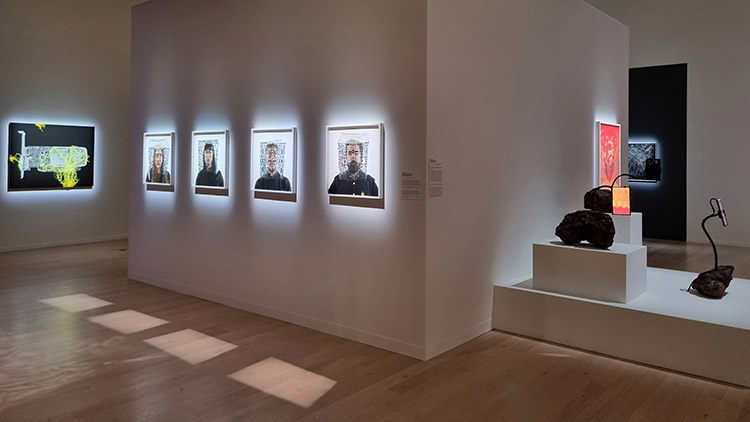
The world accelerated as one industrial revolution after another produced societal and aesthetic changes. It was in the 19th century that the serial treatment of subjects became widespread in painting, as if to better grasp every aspect of them. In an age of unbridled use of artificial intelligence algorithms in industry and art alike, it is more appropriate to approach many works through their multiple versions. Increasingly, artists are literally collaborating with programs capable of generating their works in infinite variations. When the results are striking, it is up to them to interrupt the autonomous processes they had initiated. But what has been new in recent years is that we can all use such interfaces to, for example, refine our multiple online profiles. In this way, we have a certain closeness to the creations that come out of iterative or generative processes. The exhibition Endless Variations of the Canadian Cultural Center that is in the program of the Nemo Biennale should be seen as a studio where the works are in the process of being made.
ARTISTS _ Nicolas Baier, Salomé Chatriot, Chun Hua Catherine Dong, George Legrady, Caroline Monnet, Nicolas Sassoon, Christa Sommerer & Laurent Mignonneau, Oli Sorenson, Timothy Thomasson.
DOCUMENTATION _ Canadian Cultural Center, YouTube.
Samples of the self
In the program of the Nemo Biennial
CAC La Traverse, Alfortville, November 29, 2023 - January 13, 2024

Marc Domage.
A sample provides an idea of the whole and, when there are several, they allow us to make decisions. But sampling is also an artistic practice, notably of sounds and images – still or moving – consisting of assembling them to reassemble them, until ultimate perfection. More and more often, contemporary artists make their choices online much like their masters used to buy their pigments in art shops back in the days. Online we only give samples of ourselves, to never fully reveal who we are. There we appear in many forms when it is not through multiple identities. The artists of the exhibition Samples of the self continuously oscillate between the private sphere and the world of art, as much as from the real spaces to the virtual ones. Therefore, it is in-between where their creations emerge with intentions as well as shapes interacting.
ARTISTS _ Ines Alpha, Renaud Auguste-Dormeuil, Emilie Brout & Maxime Marion, Grégory Chatonsky, Dasha Ilina, Bettie Nin, Fabien Zocco.
[In]Material
During Paris + by Art Basel
With JST (Janine Sarbu & Santiago Torres)
Metahaus, Paris, October 20th - 26th, 2023
![[In]Material](../img/exhibitions/inMat.jpg)
The idea of immateriality in art has never been as important as nowadays. We could consider that artworks have always emerged from the mind as Leonardo da Vinci, in his time, believed all of them to be « cosa mentale ». In the sixties, while many artists calculated their geometric abstractions, conception started moving from the human brain to the computer. So finally, during the eighties, Jean-François Lyotard and Thierry Chaput presented their exhibition Les Immatériaux at the Pompidou Center in Paris, resembling a manifesto to post-modernity. The creative potential of electronics and computers were on display with a scenography composed of transparency through its use of mesh fences. We all know what happened next: an omnipresence of digital components that more and more artists hack when they do not collaborate with artificial intelligence to publish their virtual pieces on online platforms. What is relatively new is the interest of a new generation of collectors investing in digital objects; in the field of art these creations provide us with an understanding of our immaterial society. The desire of these art collectors of a new kind oscillates between limitless dreams of virtuality and an attraction to art pieces participating in a form of re-materialization of the world that has become possible thanks to the digital fabrication process. Consequently, the [ in ] material exhibition concerns hybridization by gathering artworks with different coefficients of materiality. When lack of materiality summons the sublime.
ARTISTS _ Ines Alpha, Anka, Donatien Aubert, Sebastian Barrandeguy, Matthew Biederman, Anne Blanchet, Grégory Chatonsky, Thomas Cheneseau, Marc Antoine Decavele, Félicie d'Estienne D'Orves, Pascal Dombis, Philippe Gourdon, Mihai Grecu, Anne Horel, Vidya-Kélie, Mathilde Lavenne, Solimán López, Dana & Stephane Maitec, Sandra Matamoros, Milkorva, Fred Murie & Flavien Théry, Thomas Paquet, Pierre Pauze, Sabrina Ratté, Bruno Ribeiro, Diego Sarmiento and Santiago Torres.
DOCUMENTATION _ YouTube.
Another Perspective
In the program of Art Brussels
[Senne], Brussels, April 20th – May 7th, 2023

With the successive arrival of personal computers and the Internet, artists have begun to deconstruct systems of representation, thus continuing what the cubist and abstract painters of the beginning of the last century had initiated. But haven't we all been affected by this change in perspective? To the point of having a privileged relationship with artworks that are the result of digital practices. Add to this the fact that such practices or uses have become so popular that they shift the lines between artists and non-artists. In its participatory version, the Internet is a perfect illustration of this decidedly collective approach to creation in this era of widespread re-appropriation of content that [Senne] Brussels puts into perspective.
ARTISTS _ Chiho Aoshima, Cory Arcangel, Jessica Ciocci, Jacob Ciocci, Petra Cortright, Sara Cwynar, Exonemo, JODI, Oliver Laric, Olia Lialina & Dragan Espenschied, Guthrie Lonergan, Thomas Ruff, Penelope Umbrico, Artie Vierkant.
DOCUMENTATION _ Another Perspective.
The Fusion of Possibilities
In the program of ISEA
Topographie de l'Art, Paris, April 15th – June 15th, 2023

Yesterday's possibilities are today's realities that we are constantly merging to make them even better. Over the last sixty years, many artists with a strong affinity for technology of their time have anticipated our environments or uses with their creations. It is often by hacking innovations that they innovate in turn when their multiple practices come together as their techniques agglomerate. From the scientific laboratory to the artist's studio, everything happens at the junction of the material and the immaterial, as well as that of intelligence and data, without forgetting the realities that are brought together by considering them extended. There is no longer an autonomous field of research, isolated from the others. In an age when the notion of artistic tendency is no longer operative, the exhibition The Fusion of Possibilities at the Topographie de l’Art, with artworks from converging practices, aims to be the expression of the symbiosis of ideas as well as of forms.
ARTISTS _ Donatien Aubert, Golnaz Behrouznia, Samuel Bianchini, Thibault Brunet, Caroline Delieutraz, Pascal Dombis, Kamilia Kard, Marie Lelouche, Julien Maire, Albertine Meunier, Sabrina Ratté, Marion Roche, Vera Röhm, François Ronsiaux, Nicolas Sassoon, Michele Spanghero, Victoire Thierrée et Peter Weibel.
PERFORMANCES _ Julien Maire, Halos. Kamilia Kard, Toxic Garden - Dance Dance Dance.
DOCUMENTATION _ La Fusion des Possibles.
AI in art, a matter of encounters
In the program of The Future of Living
Bozar, Brussels, December 2nd – 3rd, 2022

Artificial intelligence is a concept that scientists started to describe before really programming it. Simultaneously, authors of fiction started to give it form without any constraints. Finally, there are digital artists who, in the field of art, confront the public with artificial intelligence through generative or interactive artworks. These artists are generally motivated by the idea of initiating encounters and sometimes even, dialogues within the physical spaces of galleries or art centres. By experiencing the artworks of artificial intelligence, the public increases its intimate knowledge of it. To the point that our comments complete these performative installations which, because of their relative autonomy, escape the control of the artists who entirely conceived and built them.
ARTISTS _ Jana Bernartova, Maša Jazbec in collaboration with Varvara & Mar, Mathieu Zurstrassen.
WORKSHOP _ Mihai Grecu.
DOCUMENTATION _ The Future of Living.
Persistent Worlds
& Exploratory Practices
In the program of the Art [ ] Collector prize
24Beaubourg, Paris, November 8th – 19th, 2022

Thibault Brunet collects points of view, in the immediate as well as at a distance, while continuously dialoguing with the history of the image and the art of shooting. He summons the origins of the photographic medium when he captures territories with a laser that he literally circumscribes in extended durations, annihilating any idea of movement. One thinks of Louis Daguerre's Boulevard du Temple, where passers-by have disappeared during a long exposure. The black circular surfaces of his Circumscribed Territories mark the initial positions of the capture devices. Back in his studio with multiple interfaces, the artist then edits the points of view of the three-dimensional spaces of his territories. The freedom of movement he enjoys is total, like that of a bird in full flight, it recalls the practices and uses of certain video games. The pictorial is also omnipresent in the aesthetic that Thibault Brunet develops over time, like a watermark. Although no brush has ever touched the interiors or objects of the banal, he illustrates with uncertain contours that melt into the darkness of absence. And when he approaches this very particular space, the stairwell, it is with the meticulousness of a filmmaker that he operates, using complexity as the only trigger of suspense.
ARTIST _ Thibault Brunet.
PDOCUMENTATION _ Art [ ] Collector, Art in the Digital Age.
Computing Beauty
Nft Gallery A.dition, Lounge de Coloris, Walkerhill, Seoul, May 27th - September 27th 2022
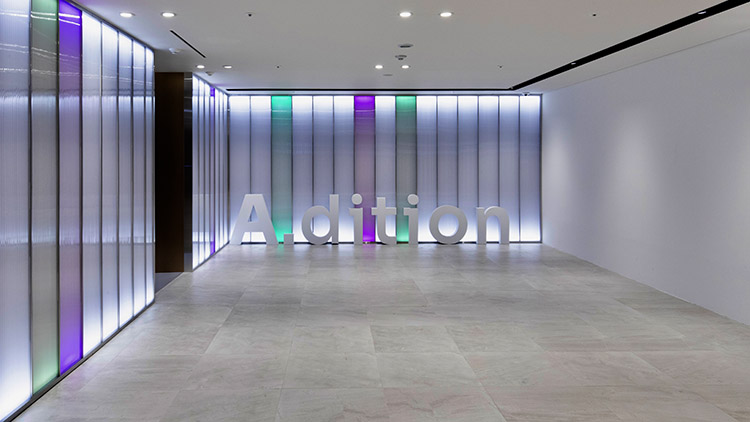
Numbers and artworks have always been interlinked, much like harmony in musique and composition in painting. However, it must be admitted that, since the dawn of computers, there are more and more artists collaborating with machines. In fact, beauty can also be computed, even with the help of artificial intelligence algorithms. Thanks to the Internet, digital artworks are more accessible than ever. Therefore the contemporary art scene, once again, has to adapt to this era of decentralized technology. The artworks of this exhibition have all been partially or totally computed. Furthermore they are all collectible as Non Fungible Tokens online, where the current aesthetic of our time is deployed.
ARTISTS _ Matthew Biederman, Grégory Chatonsky, Catherine Ikam & Louis Fléri, Kamilia Kard, Jan Robert Leegte, Marie Lelouche, Soliman Lopez, MAOTIK, ORLAN, Antoine Schmitt, Santiago Torres, Frederik de Wilde.
PERFORMANCE LIVE _ Antoine Schmitt & Franck Vigroux, ATotal.
NFT PLATFORM _ Art Consortium.
Art Me!
With Valérie Hasson-Benillouche
Galerie Charlot, Paris, April 21st - July 30th 2022

Mr Twodeers.
At the heart of the Art Me! exhibition, there is the will to reconsider what unites artists to their artworks that they inhabit, populate with characters or open to the public. The idea, therefore, as Allan Kaprow suggested in the Sixties, is that nothing must separate art from life as attested by his Essays on the Blurring of Art and Life (1993). And there are, nowadays, still artists to perform happenings, whether it is in all discretion, in the public space, as well as on the Internet. Benefiting from the magic or efficiency of the contemporary technologies to embody their creations. We are bound to recognize that there are many techniques that encourage artists to rethink the nature of their relationship to the characters that literally ‘populate’ their works. Here one thinks of those of scanning, modeling, or motion capture when it is not by using artificial intelligence. The 3D models thus represented are in the exact measure of real people. It could be a matter of detail, as one might think, but which are likely to reinforce the empathy of the audience inevitably recognizing itself in a gesture or a posture strangely familiar. But revolutions, in art, are also the consequences of the democratizations of the artistic practices due to the emergence of innovations going from the Kodak film to the Apple iPhone. Not to mention the platforms of sharing, precisely where the artistic practices mixed with the hobbyist ones, without knowing who influences who! Indeed, how many artists collect their image files by tracking them through their index names in the realm of emojis to create collages that continue ‘all over’ the frames? Finally, there are the artworks of which we are the heroes: the creations that we experience, through manipulation or virtually. By interacting, we magnify technical objects, in immersion, without any body, we become the essential component of the artwork that we complete. When we are not, quite simply, the artwork itself. Like happening artists and more widely performers who, in the action, not only make an act of creation, but also are the creation itself. This brings us back to the French translation of Allan Kaprow's book that is even more precise: L'art et la vie confondus.
ARTISTS _ Aram Bartholl, Chun Hua Catherine Dong, Pierrick Sorin, Jeanne Susplugas, Penelope Umbrico, Universal Everything, Eric Vernhes, Du Zhenjun.
DOCUMENTATION _ Galerie Charlot.
Decision Making: The Decisive Instant
With Alain Thibault, in collaboration with Catherine Bédard
In the program of the Nemo Biennial
Canadian Cultural Centre, Paris, Decembre 10th 2021 - April 15th 2022

Decisions are the result of complex cognitive processes. Considering them collectively, as they involve our shared futures, makes them nothing less than crucial. But, more and more often, we include machines in such processes through decisional algorithms. Of course, this raises questions that artists know how to put into perspective. Because the age we are currently living in, a simple instant in the history of our planet, is decisive considering the choices available so we can move forward in a world ruled by the responsible and ethical development of Artificial Intelligence. It is now that human rights are at stake, that we can decide what will emerge from the use of our personal data. Experiencing artworks created from decisive processes extracted from the invisible propels us into an immediate future that, for now, still belongs to us.
ARTISTS _ Adam Basanta, Naomi B Cook, Aram Bartholl, Baron Lanteigne, Véronique Béland, France Cadet, Pascal Dombis, Jean Dubois, Marie-Eve Levasseur, Rafael Lozano-Hemmer, Sabrina Ratté, David Spriggs, Maija Tammi, Varvara & Mar.
PERFORMANCE _ Matthew Biederman & Alain Thibault.
DOCUMENTATION _ Canadian Cultural Centre, Art in the Digital Age, YouTube.
Metastability & Pantopie
In the program of the NOVA_XX Biennial
Centre Wallonie-Bruxelles, Paris, December 8th 2021 - February 12th 2022

Call for proposal. Female artists. Quebec, France, Wallonie-Bruxelles.
CURATORS _ Marie du Chastel, Dominique Moulon and Alain Thibaut in collaboration with Sara Anedda, Evelyne Deret et Stéphanie Pécourt.
ARTISTS _ Marion Balac, Véronique Béland, Rocio Berenguer, Cindy Coutant, Eduardo Andres Crespo, Marjolijn Dijkman, Anouk Kruithof, Eva L’hoest, Caroline Le Méhauté, Sylvie Lehmers, Katherine Melançon, Anna Raimondo, Sabrina Ratté, Molly Soda, Victoire Thierrée, Noriko Yamaguchi.
DOCUMENTATION _ Centre Wallonie-Bruxelles.
Inner Telescope
With Charlot gallery in the program of the Nemo Biennial
Plateforne, Paris, November 24th - 28th 2021

Artist Eduardo Kac spent years preparing the protocol for producing his outer-space work Inner Telescope, which was executed by astronaut Thomas Pesquet. He methodically planned the cuts and folds that would finally be executed on 18 February 2017 in zero gravity, at an altitude of about 350 km. Thus one the most technical objects that humanity has ever created, the International Space Station, provided the venue for the paper telescope choreography. It even made us forget the extreme speed at which the ISS was travelling—an astounding 28,000 kmh. The artwork and the setting seem to be diametrically opposed. The utter fragility of the work compared to the solid windows of the cupola, through which we can make out Earth, which itself appears so fragile. The “M” in this weightless sculptural poetry conveying the idea of an optical instrument is a collective “me”, because it is pointed toward us. The preliminary sketches, fleeting performance and resulting creations all speak to our desire to travel outward and our duty to look inward.
ARTIST _ Eduardo Kac.
PERFORMANCE _ Frédéric Deslias, #Exoterritoires.
BOOK _ Télescope intérieur, éditions de l'Observatoire de l'Espace du CNES.
DOCUMENTATION _ Nemo Biennial.
Dialogs about obsession
In the program of the Nemo Biennial
Avant Galerie Vossen, Paris, September 23rd - October 31st 2021

Often, little obsessions that agitate us are hidden in the invisible when art, sometimes, magnifies them. Because obsession, for the common mortal according to psychoanalysts, is a source of suffering that cannot always be explained. Yet, when it comes to artists who know how to express it so well, it is central to their aesthetic. The serial approach to a theme, whatever it may be, allows them to take it to the limit. Not to mention monochrome painting, the most obsessional of quests: that of the sublime. Machines which we particularly appreciate for their ability to repeat tasks over and over again, obsession may be seen as the norm. For example, the artificial intelligence that perfectly recognizes only what we have taught them to see, to the point that it fails in its quest that is just as obsessional. Finally, there are the social media algorithms that show us only what they believe is important to us at the risk of converting our searches into little obsessions. The exhibition Dialogs about obsessions gathers four artists from different generations with series using different media but all evoking frenzy.
ARTISTS _ Geneviève Asse, Caroline Delieutraz, Grégory Chatonsky et Sam Szafran.
DOCUMENTATION _ Nemo Biennial.
Laurent Pernot
In collaboration with Tribew and in the exhibition Ode à Gaïa of Turbulences
24 Beaubourg, Paris, February 27th - 29th 2020

Fragility is one of the key issues regarding the work that Laurent Pernot creates. A kind of fragility that, far beyond beliefs, places the objects, the people and the world on the same plane in their relationship to ephemeral, whatever their temporalities that it neutralizes. Therefore, this equally concerns keys not opening doors anymore, watches that no longer tell time, flowers that will never wilt as well as animals that could no longer go extinct. The artist goes so far as to consider the negation of his own end by representing himself frozen while contemplating a winter landscape painting. Contemplation is also an essential component of his work. Yet, the poetic aspect of Laurent Pernot’s art mustn’t conceal his philosophic approach. He encourages us to reevaluate the vanity of our existences as much as our acts that, nevertheless, we have to improve in a world that really scares us so much that we use our imagination as a way to escape.
ARTIST _ Laurent Pernot.
Human Learning:
What Machines Teach Us
With Alain Thibault, in collaboration with Catherine Bédard
In the program of the Nemo Biennial
Canadian Cultural Centre, Paris, February 5th - August 28th 2020

We have taught everything to machines and continue to supply them so that they pursue the “desire” for autonomy we would like to grant them. Isn’t it time that we started thinking that we, too, learn from them by observing their specificities or qualities? If there is one community that observes the world to give us its interpretations of its transformations, it is the artistic community. Human Learning. What Machines Teach Us is an exhibition that documents the world using the technologies that shape it. The works in the exhibition feature a large variety of styles: interactive devices that make us learn their playabilities, generative installations whose processes are entirely autonomous and digital creations made out of digital forms.
ARTISTS _ Matthew Biederman, Emilie Brout & Maxime Marion, Grégory Chatonsky, Douglas Coupland, Chun Hua Catherine Dong, Emilie Gervais, Sabrina Ratté, David Rokeby, Justine Emard, Olivier Ratsi, Louis-Philippe Rondeau, Samuel St-Aubin, Skawennati, Xavier Snelgrove & Mattie Tesfaldet.
PERFORMANCE _ Purform.
DOCUMENTATION _ Canadian Cultural Centre, Art in the Digital Age, YouTube.
Particle Ruins
With Arnaud Lévénès, in the program of the Nemo Biennial
La Capsule, Le Bourget, January 23nd 2019 - April 24th 2020
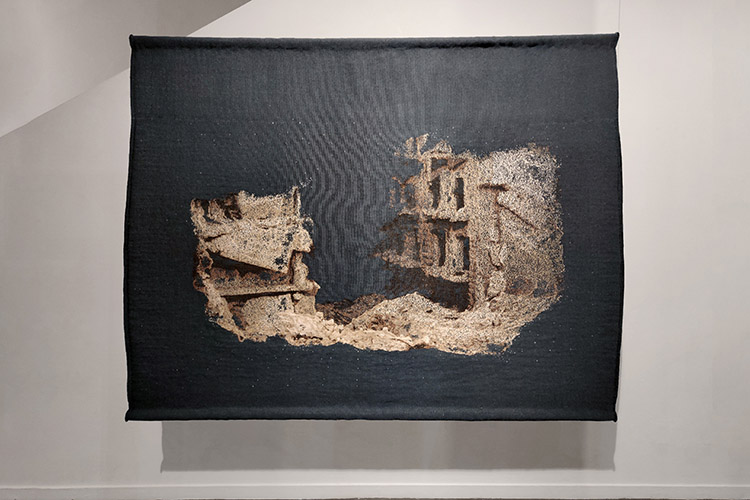
The images from the exhibition Particle Ruins by Thibault Brunet seem to document as many unfinished sculptures. In the blocks, that we guess the digital immateriality, are details which have caught the eyes of professionals and ordinary people equipped with embedded cameras on their helmet or their harness. Without forgetting the drones that ceaselessly document conflicts from afar. The detailed level of the artist’s ruins emerges from the fusion of multiple points of view. Because Thibault Brunet works with a large quantity of photographic data that he interprets into tridimensional spaces containing monuments or buildings partially destroyed by war. His views are deserted like ruins of the afterwards. Those which, precisely, call for reconstruction.
ARTIST _ Thibault Brunet.
DOCUMENTATION _ Nemo Biennial.
Zero Autonomy
With Gilles Alvarez, in the program of the Nemo Biennial
Cité Internationale des Arts, Paris, November 22nd - December 1st 2019

There are many ways to conceive the lack or loss of autonomy, for humans as well as machines. By analyzing our relationships with technology, we understand that this missing autonomy is an important society issue. As a matter of fact, over time, we have given our knowledge and intelligence to servers and applications. This includes our most intimate memories that we are totally unable to precisely locate. We lose our minds at the thought of having a low battery or a disconnected network, even for a short amount of time. Who has never experienced this kind of temporary missing power or service without feeling desperately helpless? Even moving around requires the computation of devices and we continue to ignore their extreme complexity. Our autonomy is progressively diminished as we delegate them with more and more tasks even though we know their potential instability. Zero Autonomy’s exhibition aims to put the human back into the machine as well as reveal the importance of our decisions and intuitions that will remain so for years to come. Algorithms, we have been told, are supposedly able to learn by themselves if, and only if, we stimulate them. It is this essential stimulation that we want to examine throughout artworks that emerge from the relations between knowledge and know-how. When artists are very close to the technological apparatus, they activate them to create art together. Beyond the lack or absence of autonomy, is the interdependency that is the essential value of today’s art in the era of digital omnipresence.
ARTISTS _ Donatien Aubert, Marion Balac & Carlos Carbonell, Adam Basanta, Rocio Berenguer, Emilie Brout & Maxime Marion, Christophe Bruno, Quentin Destieu, Benjamin Gaulon & Jérôme Saint-Clair, Elisa Giardina Papa, Varvara Guljajeva & Mar Canet, So Kanno & Takahiro Yamaguchi, Esmeralda Kosmatopoulos, Fabian Kühfuß, Pe Lang, Claire Malrieux, Egor Kraft, Julien Prévieux, Bérénice Serra avec Marion Balac, Raphaël Fabre, Mathieu Tremplin, Arzhel Prioul et Julien Toulze.
DOCUMENTATION _ Nemo Biennial.
When Code Becomes Form
Plateforme, Paris, March 15th - 31st, 2019

In March 1969, curator Harald Szeemann inaugurated his exhibition called When attitudes Become Form at the Kunsthalle in Bern. Concepts and actions were more important than the artworks themselves. The presented artists claimed the idea of the unfinished. Over time, this event became a major historical marker in contemporary art. But what shapes the art practices of artists documenting the digital society we live in fifty years later? Isn’t it the code that is everywhere, usually hidden? It is both a tool and a medium. There is no artistic medium that hasn’t been contaminated by algorithms similar to the ones that act on our everyday lives, without us even knowing it. Among artists using digital, some code by themselves while others collaborate with experts in the languages that have revolutionized all the uses. And many of their works neither really begin nor end. They conceive their generative creations by assuming the idea of the unfinished. Some of them even show code fragments that we ordinarily never see. But all of them have in common their attachment to a form of letting go when the machines are computing. Therefore, in this way, they are the first audience of collaborative artworks by definition. The value - in its mathematical definition - has replaced hue in painting, so it leaves them with infinite variations.
ARTISTS _ Tatsuru Arai, Fleuryfontaine, Ianis Lallemand, Anne-Sarah Le Meur, Soliman Lopez, Claire Malrieux.
DOCUMENTATION _ Plateforme Paris.
The Origin of the (Digital) World
With Gilles Alvarez, in the program of the Nemo Biennial
Cité Internationale des Arts, Paris, November 15th - 25th 2017

Nicolas Schöffer, Chronos 10 , 1969.
The Origin of the (Digital) World brings back three high points from the end of the 1960s where we observe an intensified activity at the crossroads of arts and technologies. Beginning with the 9 Evenings: Theatre and Engineering that took place in New York in 1966, which are the source of the Experiments in Art and Technology group that engineers Billy Klüver and Fred Waldhauer founded with artists Robert Rauschenberg and Robert Whitman in 1967. On the West Coast of the United States and still in 1966, Maurice Tuchman introduced the Art and Technology Program at the Los Angeles County Museum of Art. The program aimed to connect artists such as Andy Warhol with American brands. Finally, it is in 1968 that curator Jasia Reichardt organized the Cybernetic Serendipity exhibition at London’s ICA.
ARTISTS _ ScanLAB, Nicolas Schöffer.
DOCUMENTATION _ Nemo Biennial.
Variation
In the program of the Nemo Biennial
Cité Internationale des Arts, Paris, November 15th - 25th 2017
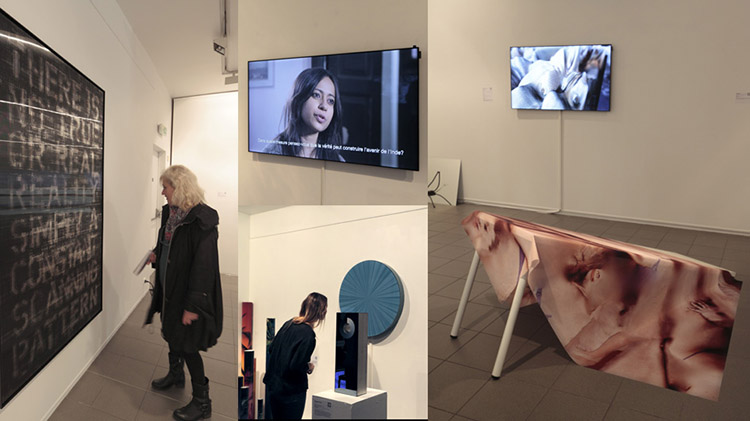
Variation is an annual exhibition of the contemporary digital art.
ARTISTS _ Hélène Bellenger, Martin Bricelj Baraga, Thibault Brunet, Yuxi Cao (James), Charles Carmignac, Félicie d’Estienne d’Orves, Gregory Chatonsky, Pascal Dombis, Thierry Fournier, Virgile Fraisse, Benjamin Gaulon, Pascal Haudressy, Eduardo Kac, Esmeralda Kosmatopoulos, LAb[au], Jean-Benoit Lallemant, Pe Lang, Fabien Léaustic, Marie Lelouche, Soliman Lopez, Xavier Lucchesi, Mathieu Merlet Briand, Jonathan Monaghan, Philippe Perrin, Bertrand Planes, Lucie Planty, Sabrina Ratté, Po Sim Sambath, Stéphane Simon, Dominique Sirois, Jeanne Susplugas, Javiera Tejerina-Risso, Myriam Thyes, Lukas Truniger, Miyo Van Stenis, Mégane Voghell.
DOCUMENTATION _ Nemo Biennial.
Prophet's Time
In the program of the Nemo Biennial
Julio Gonzalez Gallery, Arcueil, November 10th - December 23rd 2017
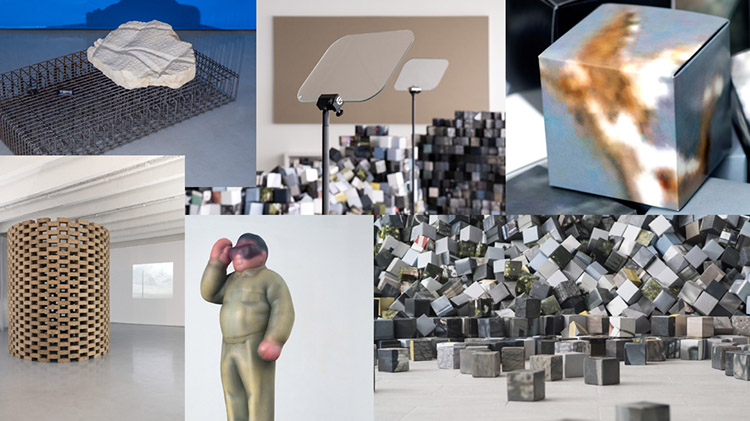
The new prophets today are mere interpreters of computational words. They will also use the accuracy of the machines to predict better worlds from Silicon Valley. In the meantime, Jean-Benoit Lallemant only delivers rather factual readings of the world at the start of the twenty-first century, a world Andre Malraux had foreseen as spiritual. Inevitably using the technologies of his time, Lallemant combines them with the traditional materials of art history, integrating discoveries and innovations, occasionally turning them into criticism. At the peak of a clash between the USA and North Korea, he refers to leaders while triggering possible lines of thoughts that visitors of his exhibition are likely to appropriate. Territory is one of the central issues in his artwork, that unfolds according to societal developments echoed by networked media. However, drawing from an in-depth knowledge of Jean-Benoit Lallemant’s body of work, we feel it also tackles the relationship between the visible and the invisible; when control has to face the fight and when endeavors backfire against those who implemented them. His visual work, with inextricably intertwined components, reveals the complexity of the world. The data, he extracts from servers and appropriates, enables us to visualize it differently, from resolutely contemporary points of view.
ARTIST _ Jean-Benoit Lallemant.
DOCUMENTATION _ Biennale Némo.
Variation
Cité Internationale des Arts, Paris, October 17th - 23rd 2016

Variation is is an annual exhibition of the contemporary digital art.
ARTISTS _ Jeremy Bailey, Marion Balac, Laurent Bolognini, Jeanne Briand, Thibault Brunet, Elias Crespin, Magali Daniaux & Cédric Pigot, Fred Delangle, Caroline Delieutraz, Alix Desaubliaux, Judith Deschamps, Côme Di Meglio, Renaud Auguste-Dormeuil, Félicie d’Estienne d’Orves, Thierry Fournier, Klaus Fruchtnis, Masaki Fujihata, Shaun Gladwell, Joe Hamilton, Pascal Haudressy, Jean Hubert, Tomek Jarolim, Carine Klonowski, Fabien Léaustic, Joanie Lemercier, Eliott Paquet, Michel Paysant, Bertrand Planes, Dani Ploeger, Ratsi, François Ronsiaux, Lisa Sartorio, Fito Segrera, Sliders Lab, Pierrick Sorin, Jeanne Susplugas, Systaime, Flavien Théry, Ali Tnani, Yann Toma, Santiago Torres, Raul Valverde, Visual System.
A Day's Pleasure
With Carlos Sanchez in the program of Nuit Blanche
Ecole Renard, Paris, October 1st 2016
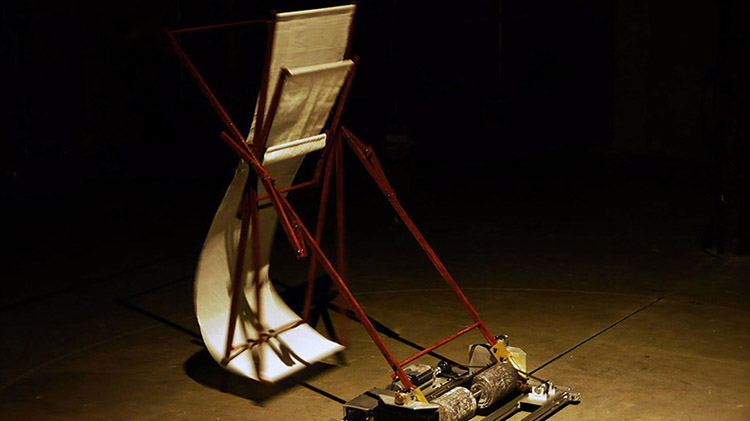
In relative obscurity, there is a long chair and it is alone. It won, this time, against the one who tried to use it. Chaplin, in other times, threw it overboard in his film A Day's Pleasure. Who never fought against a folding long chair that never really cooperates? French artist Jeremy Gobé, in collaboration with Christian Laroche, decided to accept its uncontrolled movements and finally releases it from any potential stubborn user. Finally alone, it performs under the light that magnifies it. The silence is only broken by the sounds inherent in its swinging. Without any human, totally autonomous, it loses its useful value. Freed from weight, it even seems to escape any form of gravity. The extreme flexibility of its undulations is due to the mechanical counterweight that drives it. Therefore, it is only about lightness. The fabric of its sails flapping in the wind appear completely unpredictable. Its unpredictability constituting the essential quality that it will never lose. A quality that nevertheless exasperated Chaplin’s character to the highest degree. While modern times are those of the liberation of objects of any kind. At the risk, sometimes, to exasperate us even when they compel us. Unless we disconnect while we still can. And this is perhaps the critical part of this robotic art piece that encourages us to reconsider the business of predictability in this era of digital.
ARTIST _ Jeremy Gobé.
Compagny Services
Plateforme, Paris, April 1st - 24th, 2016

Some services, at a time of exponential growth, actively participate in shaping the society that has become ours. Getting close to a “zero marginal cost”, they are at the center of what the American essay writer Jeremy Rifkin calls the Third Industrial Revolution. And not a week passes without one of them making the social and political headlines here or there. Yet, the art world is not a stranger to this growth of the services because there are artists that seek inspiration by proposing objects that seem like products. The internet, inevitably, is overflowing with a supply that these same artists distort or use as we would use tools or techniques in olden times. Except that they also criticize it. Artistic practices - which evoke the ones, more pop, from the 1960s that before now depicted the society - are developed from the services that we are offered, or rather that are imposed upon us, without forgetting the ones of the dark web. But the world has changed these past decades, and today’s works are proportional to the societal changes that Internet has only initiated by making them possible. There is, in the essential of these artists, a common desire to capture what is generally part of the flows. With this, they give us the occasion to contemplate the resonances, beyond the data ecosystems, to “think” elsewhere and differently.
ARTISTS _ Émilie Brout & Maxime Marion, Caroline Delieutraz, Pascal Dombis, Benjamin Gaulon & Martial Geoffre-Rouland, Carine Klonowski, Nicolas Maigret, Yann Toma.
DOCUMENTATION _ Plateforme Paris.
Variation Show Off
In the program of the Nemo Biennial
Espace des Blancs Manteaux, Paris, October 19th - 25th, 2015
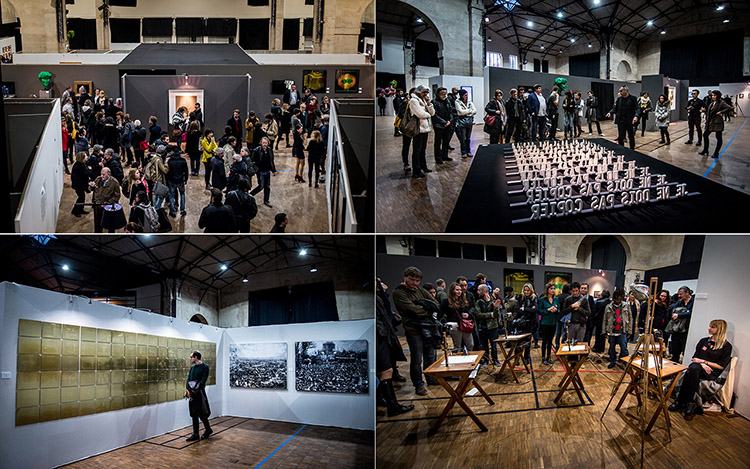
Variation Show Off is an annual exhibition of the contemporary digital art.
ARTISTS _ Donald Abad, Memo Akten, Art Orienté Objet, Jean-Pierre Attal, Cécile Babiole, Marion Balac, Maurice Benayoun, Samuel Bianchini, Matthew Biederman, Julien Borel, François Brument, Christophe Bruno, Edmond Couchot, Luc Courchesne, Michaël Cros, Enora Denis, Quentin Destieu & Sylvain Huguet, Come di Meglio & Eliott Paquet, Pascal Dombis, Jas Domicz, Reynald Drouhin, fleuryfontaine, Lia Giraud, Shaun Gladwell, Juliette Goiffon & Charles Beauté, Claudia Hart, Pascal Haudressy, Catherine Ikam & Louis Fléri, Eduardo Kac, Jean-Benoit Lallemant, HeeWon Lee, Joanie Lemercier, Julio Le Parc, Selma Lepart, Juan Le Parc, Julien Levesque, LIA, Christophe Luxereau, Laurent Mareschal, Audrey Martin & Thomas Rochon, Mazaccio & Drowilal, Albertine Meunier, Barnabé Moinard, ORLAN, Alejandro Otero, Rolando Pena, Pascale Peyret, Bertrand Planes, Dani Ploeger, Olivier Ratsi, Théoriz Studio & Pia MYrvoLD, Patrick Tresset, Francois Vogel, Du Zhenjun.
DOCUMENTATION _ Nemo Biennial.
Art And Digital Resonating:
Consequences
In the program of the Nemo Biennial
Maison Populaire, Montreuil, October 7th - December 12th 2015

History of art is indivisible from that of science, which is the source of the innovations we take hold of. There are works that have emerged from the digital’s democratization, while others result from its use in research laboratory, and from bio and nanotechnologies that come out of it. Most of the creations that use the living or the infinitely small come from digital processes although they are presentable without any electronics, or any power supply. It is also the case with objects or rapid prototyping sculptures that renew artistic practices by becoming accessible to all.
ARTISTS _ Renaud Auguste-Dormeuil, Aram Bartholl, Valérie Belin, Laurent Bolognini, Thibault Brunet, Jean-Benoit Lallemant, Bertrand Planes, Rafaël Rozendaal, Clement Valla.
DOCUMENTATION _ Catalog.
Art And Digital Resonating:
Re-Emergence
Maison Populaire, Montreuil, May 5th - July 5th, 2015
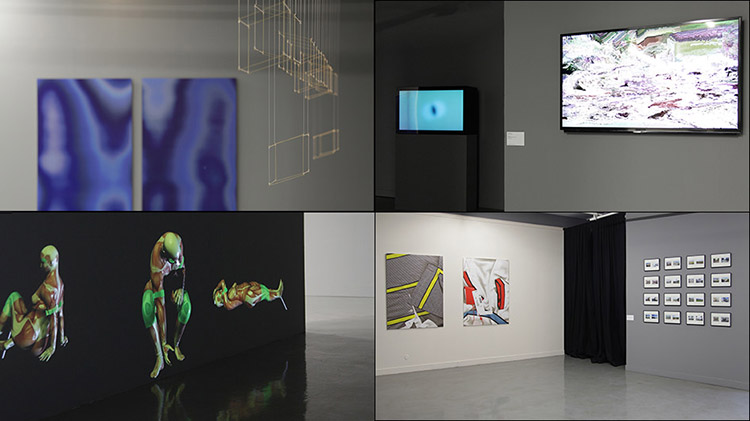
In art, the emergence of a medium implies new trends. It is also the source of the reactivation of historical practices. In painting, the use of the nude has been updated with the appearance of photography and videography, until the era where images are calculated. Movements, which were magnified yesterday, are now controlled digitally. Not to mention the landscape, where machines are the ones that travel the world in order to capture the tiniest nooks. Contemporary artists ought to seize the tools and digital contents in order for timeless problems to resonate in their works.
ARTISTS _ Cory Arcangel, Elias Crespin, Caroline Delieutraz, Pascal Dombis, Benjamin Gaulon, Pascal Haudressy, ORLAN, Jacques Perconte, Flavien Théry.
DOCUMENTATION _ Catalog.
Art And Digital Resonating:
Convergence
Maison Populaire, Montreuil, January 13th to April 4th, 2015
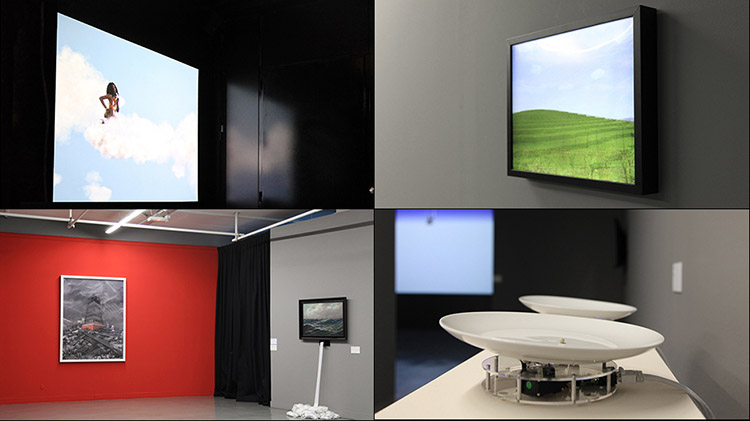
Art and digital, when they are combined, 'reason' together. Today, many works are initiated by a search engine or an electronic device. Networking artistic practices and non-professional use are mixed up. To fit in, artists divert the social media that we appropriate. Because digital cultures are today very widely shared.
Networked, we are here and there at the same time, possibly exchanging with all, around a community that is more and more global. The digital has invested in all the private, public or professional spheres of our society, profoundly modifying the relations between one another. There are artists who represent the world as it is or as we fantasize it, while others reveal it to us differently, in order to criticize it. Yet, all of them are affected, in their artistic use of societal problems, by the presence of the digital, at the core of our societies.
ARTISTS _ Samuel Bianchini, Marie-Julie Bourgeois, Émilie Brout & Maxime Marion, Petra Cortright, Olia Lialina, Christa Sommerer & Laurent Mignonneau, Samuel St-Aubin, Gwenola Wagon & Stéphane Degoutin, Du Zhenjun.
DOCUMENTATION _ Catalog.
Show Off Variation
Espace des Blancs Manteaux, Paris, October 20th - 26th, 2014

Show Off Variation is a contemporary digital art fair.
ARTISTS _ Yacine Ait Kaci, Memo Akten, Kohira Atsunobu, Pascal Bauer, Cécile Beau & Nicolas Montgermont, B. Bellabas, Maurice Benayoun, Laurent Bolognini, Marie-julie Bourgeois, Emilie Brout & Maxime Marion, François Brument & Sonia Laugier, France Cadet, Elisabeth Caravella, Caroline Delieutraz, Reynald Drouhin, Benjamin Gaulon, Mihai Grecu, Lyes Hammadouche, HeHe, Guillaume Herbaut, Norbert Hillaire, Catherine Ikam & Louis Fleri, Olga Kisseleva, Ianis Lallemand, Anne-Sarah Le Meur, NBIA (No Budget Internet Art), Juan le Parc, Éva Magyarósi, Damien Marchal, Pia MYrvoLD, Nonotak, ORLAN, Jacques Perconte, Matt Pyke, Baptiste Rabichon, Etienne Rey, Félix Luque Sánchez, Scenocosme, Samuel St Aubin, Flavien Théry, Yann Toma, François Zajéga.
Show Off
With Délégation Générale du Quebec à Paris
Espace Pierre Cardin, Paris, October 21st - 23rd 2013
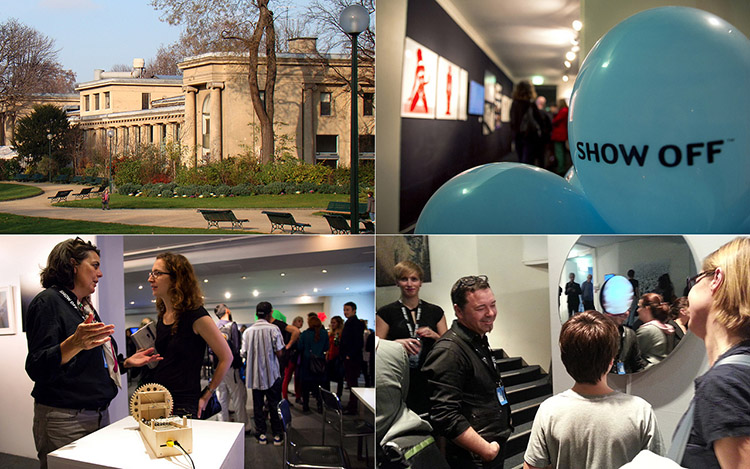
Show Off is a contemporary digital art fair.
ARTISTS _ Yacine Ait Kaci, Hugo Arcier, Art of Failure, Cécile Babiole, Gabriel Barcia-Colombo, Maurice Benayoun, Samuel Bianchini & Sylvie Tissot, Matthew Biederman, Vincent Broquaire, Thibault Brunet, Alexandre Castonguay, Christophe Bruno & Cécile Noguès, Grégory Chatonsky, Miguel Chevalier, Luc Courchesne, Magali Daniaux & Cédric Pigot, Magali Desbazeille, Djeff, Pascal Dombis, Jean Dubois, Renaud Duval, Electronic Shadow, Vincent Fournier, Jeff Guess, David Guez, Lynn Hershman, Norbert Hillaire, Catherine Ikam & Louis Fleri, Eduardo Kac, Ulf Langheinrich, Jan Robert Leegte, Joanie Lemercier, Julien Levesque, Christophe Luxereau, Nicolas Maigret, Misha Margolis, Alexandre Maubert, Katherine Melançon, Mathieu Mercier & Sismo Designers, Naziha Mestaoui, Albertine Meunier, Robyn Moody, Pia MYrvoLD, Joseph Nechvatal, Catherine Nyeki, ORLAN, Guillaume Paris, Jacques Perconte, François Quevillon, Olaf Rauh, Vincent Rioux, François Ronsiaux, Antoine Schmitt, Marie Sester, Sliders, Christa Sommerer & Laurent Mignonneau, Edouard Sufrin, Samuel St-Aubin, Yann Toma, Trafik, Hugo Verlinde, Eric Vernhes, Jonathan Villeneuve, Gwenola Wagon & Stéphane Degoutin, Du Zhenjun.
DOCUMENTATION _ Catalog.
Show Off
Vanessa Quang Gallery, Paris, October 17th - 21st, 2012

Show Off is a contemporary digital art fair.
ARTISTS _ Burak Arikan, Samuel Bianchini, Christophe Bruno, France Cadet, Grégory Chatonsky, Miguel Chevalier, Stéphane Degoutin & Marika Dermineur, Pascal Dombis, Reynald Drouhin, Félicie d’Estienne d’Orves, Christian Globensky, David Guez, Eduardo Kac, David Letellier, Julien Levesque, Albertine Meunier, Julie Morel, Joseph Nechvatal, Stéfane Perraud, RYbN, Société Réaliste, Olivier Ratsi, Antoine Schmitt, Michael Sellam, Christa Sommerer & Laurent Mignonneau - Flavien Théry, Lydia Venieri, Du Zhenjun.
Latent Shapes
Ars Longa, Paris, November 13rd - December 10th, 2008

“The democratization of digital cameras contributes to overwhelming us with images. The problem is not about taking photographs, but to be looking at them,” explains programmer artist Cyrille Henry. When he travels by train from Paris to Valence or from Paris to Orléans, he brings a digital camera which takes 30 photographs per second. Then, back in his studio, Cyrille Henry assembles them with the help of an algorithm that only keeps a vertical pixel line by shooting. The first line, on the left, shows the start, while the last one represents the arrival. The convention which stipulates that we should read from left to right is thereby respected. It takes between one and two thousands moments to recreate the image of a ride in the form of its temporal compression. The shootings conveived are related journeys. Here, the train slowed down, and stopped for a few pixels and then got going again. The sky was blue on June 10th, 2006, between Paris and Compiègne. We observe several dots on “Paris Valence”, which are electric wires that follow the railroads, oscillating up and down. Reflections of the inside of the wagon are added to the “Paris Orléans” landscape, where two opposed points of view cohabit. From these temporal compressions is born the expression of a horizontal stretching that evokes some painters’ technique, like Gerhard Richter’s, who stretches the pictorial matter.
ARTIST _ Cyrille Henry.
Partners
- 22,48 m2
- 24Beaubourg
- 36 degrés
- [Senne]
- A+E
- a ppr oc he
- Aeroplastics
- Alberta Pane
- Analix Forever
- Art Consortium
- Ars Longa
- Art [ ] Collector
- ART45
- Avant Galerie Vossen
- BBA
- Biennale Némo
- Bigaignon
- Binome
- Bigaignon
- Blouin Division
- Bozar
- CAC La Traverse
- Charlot
- CIFRA
- Cité Internationale des Arts
- CNAP
- CulturFoundry
- DAM
- Danae
- Daniel Faria
- Délégation générale du Québec
- Denise René
- Dix9
- Elektra
- Ellephant
- FRAC Nouvelle-Aquitaine
- FRAC Pays de la Loire
- Henrique Faria
- In Situ
- Incognito Artclub 24/24
- Julie Caredda
- Kate Vass
- La Capsule
- La Collection
- LACMA
- Le Cube
- Le Bicolore
- Le Fresnoy
- Louise Alexander
- Maison Populaire
- Metahaus
- Michel Rein
- Molior
- Muriel Guépin
- Museum of Transitory Art
- Nathalie Obadia
- New Galerie
- Odalys
- Olivier Waltman
- Olivier Waltman
- Pari Nadimi
- Paule Anglim
- Perte de Signal
- Pierre-François Ouellette
- Planète Rouge
- Plateforme
- Rabouan Moussion
- Richard
- RX
- Valeria Cetraro
- Sedition Art
- Topographie de l’Art
- Vanhaerents Art Collection
- Villa des Arts
- WRO Art Center
- Yumiko Chiba Associates
- Zeto Art